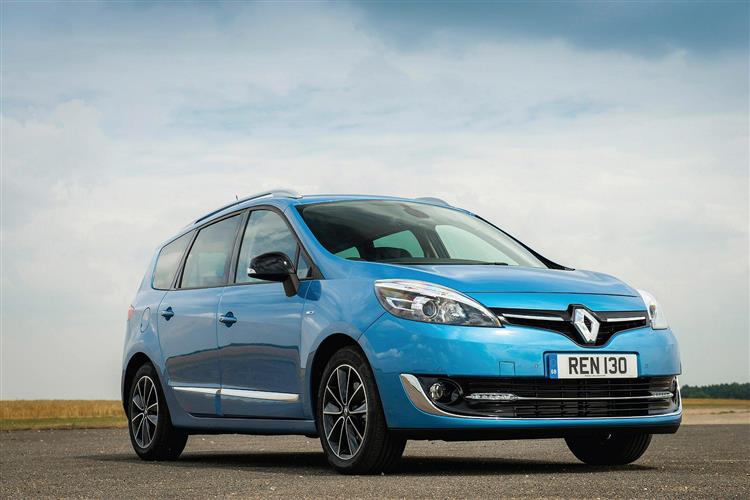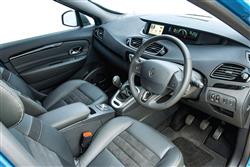RENAULT'S GRAND DESIGN (some text hidden) --NONE--
By Jonathan Crouch
Introductionword count: 83
Renault was the first brand to properly meet the needs of compact MPV buyers wanting seven seats. The design in question was the French brand's Grand Scenic model, a People Carrier we're looking at here in the further facelifted second generation form that was sold between 2013 and 2016. In this guise, this dependable MPV continued to offer a smarter spin on a well established theme. Practical, safe, quiet, comfortable, efficient to run and relatively affordable, it still ticks a lot of boxes.
Modelsword count: 12
5dr compact MPV (1.2, 1.6 petrol, 1.5, 1.6 diesel [Dynamique Tom Tom])
Historyword count: 460
When it comes to cars, established market categories are all very well, but sometimes, they just don't suit the lives that many of us lead. Take People Carriers. Or, more specifically, let's take this one, this much improved second generation version of Renault's seven-seat Grand Scenic that was sold between 2013 and 2016. MPVs have always been 'A Good Idea' for families but it wasn't so long ago that buying such a car was a question of choosing between two extremes. In selecting a People carrier, you either went for one that was so huge you were hardly likely to ever use all its capacity. Or one so compact that trying to cram in a family of seven and even some of their luggage ended up being a contortionist exercise in logistics. Predictably, it was the innovationists in the MPV market, Renault, who first recognised the problem and back in 2004, launched the first generation version of the Grand Scenic, a car built around a 'Goldilocks principle' further perfected by the second generation version originally launched in 2009. Namely, that of a People Carrier that wasn't too big and wasn't too small, but was just right. You'd think that getting such a balance right would be fairly straightforward wouldn't you? Not a bit of it. The trend for making compact MPVs more family-flexible by equipping them with seven seats began around the turn of the century with cars like Vauxhall's Zafira. But the problem was that the models in question were made no bigger to cope with their extra potential passengers, so often felt terribly cramped. That was why the original first generation version of this Grand Scenic was so significant. It was the first compact people carrier to feature an extended wheelbase big enough to make the third seating row actually usable - without creating a vehicle that was too van-like. Like Renault's previous people carrying innovations - the Espace of 1985 and the Scenic of 1999 - this one was quickly copied by other MPVs also aiming to offer a better family balance between size and wieldiness, most notably the Ford S-MAX of 2006. Renault countered that car by launching the original version of the second generation Grand Scenic three years later, but the competition kept on coming: Peugeot's 5008 in 2010, Vauxhall's Zafira Tourer in 2012 and the MK2 Citroen Grand C4 Picasso in 2013. Still, the Grand Scenic did its best to keep up, with an update in early 2012 quickly followed by a more far-reaching package of changes in the Spring of 2013 that created the smarter, more efficient version we're going to review here as a prospective used car buy. It sold until the arrival of an all-new third generation model in late 2016.
What You Getword count: 1057
Outward aesthetics didn't use to be a very important priority for People Carrying customers but the motor industry has clearly decided that they should be, with products in this segment like Citroen's Grand C4 Picasso and Vauxhall's Zafira Tourer fighting tooth and nail for driveway cred. It's a trend this further improved second generation Grand Scenic had to follow - without prioritising fashion over function. Hence this revised version's more contemporary front end that sees a larger Renault badge taking centre stage on the smarter bonnet. The A-pillars, the wings, the bumper and the headlights were also re-styled in pursuit of what the brand hoped was a stronger, sportier look. Details include black high gloss elements around the grille and the use of chrome trims around smarter LED daytime running lights. The boomerang-shaped back lights are supposed to give a high-tech feel to the steeply raked back screen with the line of the clusters extending forward along the flanks following a character line supposed to add a bit of dynamic appeal to the side view. But enough on the aesthetics: what about the practicality? It ought to be good. After all, this car is 216mm longer than the ordinary five-seat Scenic model, which makes it very nearly the size of the huge third generation Espace MPV that Renault deleted from its range in 2012. The extra length certainly isn't quite enough for this car to be able to take seven full-sized adults in long distance comfort. The difference here though over most compact seven-seater MPVs is that with a few compromises, you can get close. The seats in the second row slide collectively or individually backwards and forwards, so you can set them to offer good legroom for second or third row passengers, though not both. Mostly, owners will probably choose to maximise second row legroom and keep the back two seats for kids or adults on short journeys. Getting to that back row requires a certain level of agility that may tax Grandma on your Sunday outing with her and the kids to the local garden centre. Still, once she's in place and the seat backs ahead have been suitably tweaked forward, she should be comfortably enough to avoid leg stretching exercises in the coffee shop when you arrive. Headroom for taller folk may be a bit limited though. There are no such issues in the middle row of course, providing of course you don't have to give too much away to those behind. Three individual chairs are provided and all can slide and recline to offer greater comfort on longer journeys. It's here you realise what a triumph of child-friendliness this cabin is, with door pockets designed for drink bottles, blinds for the windows and even a couple of concealed under-floor storage spaces. We like the thoughtful touches too. Like the design of the tray tables which sees them recessed into the seat backs so as not to clout your kids' knees. And the way the centre storage box can slide forward so that there's ample legroom in the centre middle seat. If you have pushed that storage box right forward - as you might do so the middle rear seat can be pushed right forward so that, for example, you can keep a better eye on a child in a booster seat - then up-front, you'll find that it rather gets in the way of the two main cupholders in the centre console. Just as well then, that there are many more drinks holders dotted around the interior, part of a plethora of storage that runs to forty different compartments collectively creating 83-litres of storage space, so locating a lost Yorkie bar or set of keys could be the work of more than a few minutes. For front folk, that includes a huge chilled glovebox and useful under-seat storage slide-out trays. But there are many other reasons why a seat at the wheel of this Grand Scenic is such a pleasant place to be. The large wide windscreen makes the cabin feel spacious and airy - even more so if you've opted for the huge panoramic glass sunroof. Plus the driving position offers loads of adjustment, with a seat that can be jacked so high that even the shortest driver gets a commanding view. The soft-touch sweeping dashboard design that shows how far Renault has come in recent times in its pursuit of perceived quality and there are some very classy touches like the full colour TFT display that you can tweak to your own colour choice. You can also specify a useful extra mirror to more easily watch what the little horrors are doing. To keep them all quiet, there are three 12-volt power sockets around the cabin so that games consoles and MP3 players can be topped up. And luggage capacity? Well, as you might expect, if you're travelling seven-up, there isn't much - just 208-litres. Still, that'll be enough on your annual holiday if you also buy into the optional roofbox your Renault dealer will be happy to sell you. For the other fifty months of the year, the space on offer here will doubtless be quite sufficient. After all, once you use the easy one-touch motion to fold the rearmost chairs flat into the floor though, this area can be increased to 564-litres. That's easily enough for, say, a couple of bags of golf clubs and a baby buggy, but if you want more yet still need to carry five passengers, you can slide the second seating row forward to create up to 702-litres of space. Going further still requires you to fold the second seating row up against those at the front - sadly, they won't fold flat into the floor. That'll bring you to 1,863-litres - but you can go further still. If you've space in the garage and you're strong enough of back, you can remove the three chairs completely, to free up a massive 2063-litre space with a load length of around 2.5m. Such a performance is this process though that you've really got to want that extra couple of hundred litres of room. At least really long items can be catered for without seat-removal antics thanks to a front passenger seat that can be specified to fold forward for the carriage of really long items.
To see the full road test text contact us on 0330 0020 227
Pictures (high res disabled)

.jpg)
|
.jpg)
|
.jpg)
| |||
.jpg)
|
.jpg)
|
.jpg)
| |||
.jpg)
|

|
Scoring (subset of scores)
Category: MPV People Carriers
| Performance | |
| Handling | |
| Comfort | |
| Space | |
| Styling, Build, Value, Equipment, Depreciation, Handling, Insurance and Total scores are available with our full data feed. | |



